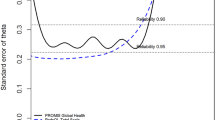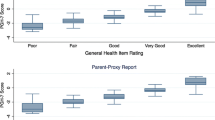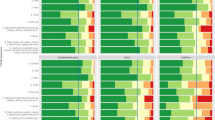Abstract
Background
The measurement of health-related quality of life (HRQOL) in pediatric medicine and health services research has grown significantly over the past decade. The paradigm shift toward patient-reported outcomes (PROs) has provided the opportunity to emphasize the value and critical need for pediatric patient self-report. In order for changes in HRQOL/PRO outcomes to be meaningful over time, it is essential to demonstrate longitudinal factorial invariance. This study examined the longitudinal factor structure of the PedsQL™ 4.0 Generic Core Scales over a one-year period for child self-report ages 5–17 in 2,887 children from a statewide evaluation of the California State Children’s Health Insurance Program (SCHIP) utilizing a structural equation modeling framework.
Methods
Specifying four- and five-factor measurement models, longitudinal structural equation modeling was used to compare factor structures over a one-year interval on the PedsQL™ 4.0 Generic Core Scales.
Results
While the four-factor conceptually-derived measurement model for the PedsQL™ 4.0 Generic Core Scales produced an acceptable fit, the five-factor empirically-derived measurement model from the initial field test of the PedsQL™ 4.0 Generic Core Scales produced a marginally superior fit in comparison to the four-factor model. For the five-factor measurement model, the best fitting model, strict factorial invariance of the PedsQL™ 4.0 Generic Core Scales across the two measurement occasions was supported by the stability of the comparative fit index between the unconstrained and constrained models, and several additional indices of practical fit including the root mean squared error of approximation, the non-normed fit index, and the parsimony normed fit index.
Conclusion
The findings support an equivalent factor structure on the PedsQL™ 4.0 Generic Core Scales over time. Based on these data, it can be concluded that over a one-year period children in our study interpreted items on the PedsQL™ 4.0 Generic Core Scales in a similar manner.

Similar content being viewed by others
References
Varni, J. W., Burwinkle, T. M., & Lane, M. M. (2005). Health-related quality of life measurement in pediatric clinical practice: An appraisal and precept for future research and application. Health and Quality of Life Outcomes, 3(34), 1–9.
Matza, L. S., Swensen, A. R., Flood, E. M., Secnik, K., & Leidy, N. K. (2004). Assessment of health-related quality of life in children: A review of conceptual, methodological, and regulatory issues. Value in Health, 7, 79–92. doi:10.1111/j.1524-4733.2004.71273.x.
World Health Organization. (1948). Constitution of the World Health Organization: Basic document. Geneva, Switzerland: World Health Organization.
FDA. (2006). Guidance for Industry: Patient-reported outcome measures: Use in medical product development to support labeling claims. Rockville, MD: Center for Drug Evaluation and Research, Food and Drug Administration.
Eiser, C. (2004). Use of quality of life measures in clinical trials. Ambulatory Pediatrics, 4, 395–399. doi:10.1367/A03-112R.1.
Varni, J. W., Burwinkle, T. M., Seid, M., & Skarr, D. (2003). The PedsQL™ 4.0 as a pediatric population health measure: Feasibility, reliability, and validity. Ambulatory Pediatrics, 3, 329–341. doi:10.1367/1539-4409(2003)003<0329:TPAAPP>2.0.CO;2.
Varni, J. W., Burwinkle, T. M., & Seid, M. (2006). The PedsQL™ 4.0 as a school population health measure: Feasibility, reliability, and validity. Quality of Life Research, 15, 203–215. doi:10.1007/s11136-005-1388-z.
Cuomo, A. V., Gamradt, S. C., Kim, C. O., Pirpiris, M., Gates, P. E., McCarthy, J. J., et al. (2007). Health-related quality of life outcomes improve after multilevel surgery in ambulatory children with cerebral palsy. Journal of Pediatric Orthopedics, 27, 653–657.
Razzouk, B. I., Hord, J. D., Hockenberry, M., Hinds, P. S., Feusner, J., Williams, D., et al. (2006). Double-blind, placebo-controlled study of quality of life, hematologic end points, and safety of weekly epoetin alfa in children with cancer receiving myelosuppressive chemotherapy. Journal of Clinical Oncology, 24, 3583–3589. doi:10.1200/JCO.2005.03.4371.
Schwimmer, J. B., Middleton, M. S., Deutsch, R., & Lavine, J. E. (2005). A phase 2 trial of metformin as a treatment for non-diabetic pediatric non-alcoholic steatohepatitis. Alimentary Pharmacology and Therapeutics, 21, 871–879. doi:10.1111/j.1365-2036.2005.02420.x.
Connelly, M., & Rapoff, M. A. (2006). Assessing health-related quality of life in children with recurrent headache: Reliability and validity of the PedsQL™ 4.0 in a pediatric sample. Journal of Pediatric Psychology, 31, 698–702.
Seid, M., Varni, J. W., Cummings, L., & Schonlau, M. (2006). The impact of realized access to care on health-related quality of life: A two-year prospective cohort study of children in the California State Children’s Health Insurance Program. The Journal of Pediatrics, 149, 354–361. doi:10.1016/j.jpeds.2006.04.024.
Windle, M., Grunbaum, A., Elliott, M., Tortolero, S. R., Berry, S., Gilliland, J., et al. (2004). Healthy passages: A multilevel, multimethod longitudinal study of adolescent health. American Journal of Preventive Medicine, 27, 164–172. doi:10.1016/j.amepre.2004.04.007.
Limbers, C. A., Newman, D. A., & Varni, J. W. (2008). Factorial invariance of child self-report across age subgroups: A confirmatory factor analysis of ages 5 to 16 years utilizing the PedsQL™ 4.0 Generic Core Scales. Value in Health, 11, 659–668.
Gregorich, S. E. (2006). Do self-report instruments allow meaningful comparisons across diverse population groups?: Testing measurement invariance using the confirmatory factor analysis framework. Medical Care, 44, S78–S94. doi:10.1097/01.mlr.0000245454.12228.8f.
Krause, E. D., Kaltman, S., Goodman, L. A., & Dutton, M. A. (2007). Longitudinal factor structure of posttraumatic stress symptoms related to intimate partner violence. Psychological Assessment, 19, 165–175. doi:10.1037/1040-3590.19.2.165.
Feldt, T., Lintula, H., Suominen, S., Koskenvuo, M., Vahtera, J., & Kivimaki, M. (2007). Structural validity and temporal stability of the 13-item sense of coherence scale: Prospective evidence from the population-based HeSSup study. Quality of Life Research, 16, 483–493. doi:10.1007/s11136-006-9130-z.
Makikangas, A., Feldt, T., Kinnunen, U., Tolvanen, A., Kinnunen, M. L., & Pulkkinen, L. (2006). The factor structure and factorial invariance of the 12-item General Health Questionnaire (GHQ-12) across time: Evidence from two community-based samples. Psychological Assessment, 18, 444–451. doi:10.1037/1040-3590.18.4.444.
Ahmed, S., Mayo, N. E., Corbiere, M., Wood-Dauphinee, S., Hanley, J., & Cohen, R. (2005). Change in quality of life of people with stroke over time: True change or response shift? Quality of Life Research, 14, 611–627. doi:10.1007/s11136-004-3708-0.
Vandenberg, R., & Lance, C. (2000). A review and synthesis of the measurement invariance literature: Suggestions, practices, and recommendations for organizational research. Organizational Research Methods, 3, 4–70. doi:10.1177/109442810031002.
McArdle, J. J. (1988). Dynamic but structural equation modeling of repeated measures data. New York: Plenum.
Duncan, T. E., & Duncan, S. C. (1995). Modeling the processes of development via latent variable growth curve methodology. Structural Equation Modeling, 2, 178–213.
Willett, J. B., & Sayer, A. G. (1994). Using covariance structure analysis to detect correlates and predictors of change. Psychological Bulletin, 116, 363–381. doi:10.1037/0033-2909.116.2.363.
Chan, D. (1998). The conceptualization and analysis of change over time: An integrative approach incorporating longitudinal mean and covariance structures analysis (LMACS) and multiple indicator latent growth modeling (MLGM). Organizational Research Methods, 1, 421–483. doi:10.1177/109442819814004.
Meredith, W., & Teresi, J. A. (2006). An essay on measurement and factorial invariance. Medical Care, 44, S69–S77. doi:10.1097/01.mlr.0000245438.73837.89.
French, B., & Finch, W. (2006). Confirmatory factor analytic procedures for the determination of measurement invariance. Structural Equation Modeling, 13, 378–402. doi:10.1207/s15328007sem1303_3.
Cheung, G. W., & Rensvold, R. B. (2002). Evaluating goodness-of-fit indexes for testing measurement invariance. Structural Equation Modeling, 9, 233–255. doi:10.1207/S15328007SEM0902_5.
Raju, N. S., Laffitte, L. J., & Byrne, B. M. (2002). Measurement equivalence: A comparison of methods based on confirmatory factor analysis and item response theory. The Journal of Applied Psychology, 87, 517–529. doi:10.1037/0021-9010.87.3.517.
Horn, J. L., & McArdle, J. J. (1992). A practical and theoretical guide to measurement invariance in aging research. Experimental Aging Research, 18, 117–144.
Little, T. (1997). Mean and covariance structures (MACS) analyses of cross-cultural data: Practical and theoretical issues. Multivariate Behavioral Research, 31, 53–76. doi:10.1207/s15327906mbr3201_3.
Varni, J. W., Seid, M., & Kurtin, P. S. (2001). PedsQL™ 4.0: Reliability and validity of the Pediatric Quality of Life Inventory™ Version 4.0 Generic Core Scales in healthy and patient populations. Medical Care, 39, 800–812. doi:10.1097/00005650-200108000-00006.
Varni, J. W., Limbers, C. A., & Burwinkle, T. M. (2007). How young can children reliably and validly self-report their health-related quality of life?: An analysis of 8,591 children across age subgroups with the PedsQL™ 4.0 Generic Core Scales. Health and Quality of Life Outcomes, 5(1), 1–13. doi:10.1186/1477-7525-5-1.
Varni, J. W., Limbers, C. A., & Burwinkle, T. M. (2007). Parent proxy-report of their children’s health-related quality of life: An analysis of 13,878 parents’ reliability and validity across age subgroups using the PedsQL™ 4.0 Generic Core Scales. Health and Quality of Life Outcomes, 5(2), 1–10. doi:10.1186/1477-7525-5-1.
Varni, J. W., Burwinkle, T. M., Berrin, S. J., Sherman, S. A., Artavia, K., Malcarne, V. L., et al. (2006). The PedsQL™ in pediatric cerebral palsy: Reliability, validity, and sensitivity of the Generic Core Scales and Cerebral Palsy Module. Developmental Medicine and Child Neurology, 48, 442–449. doi:10.1017/S001216220600096X.
Varni, J. W., Burwinkle, T. M., Katz, E. R., Meeske, K., & Dickinson, P. (2002). The PedsQL™ in pediatric cancer: Reliability and validity of the Pediatric Quality of Life Inventory™ Generic Core Scales, Multidimensional Fatigue Scale, and Cancer Module. Cancer, 94, 2090–2106. doi:10.1002/cncr.10428.
Varni, J. W., Seid, M., Knight, T. S., Burwinkle, T. M., Brown, J., & Szer, I. S. (2002). The PedsQL™ in pediatric rheumatology: Reliability, validity, and responsiveness of the Pediatric Quality of Life Inventory™ Generic Core Scales and Rheumatology Module. Arthritis and Rheumatism, 46, 714–725. doi:10.1002/art.10095.
Varni, J. W., Burwinkle, T. M., Jacobs, J. R., Gottschalk, M., Kaufman, F., & Jones, K. L. (2003). The PedsQL™ in Type 1 and Type 2 diabetes: Reliability and validity of the Pediatric Quality of Life Inventory™ Generic Core Scales and Type 1 Diabetes Module. Diabetes Care, 26, 631–637. doi:10.2337/diacare.26.3.631.
Varni, J. W., Burwinkle, T. M., Rapoff, M. A., Kamps, J. L., & Olson, N. (2004). The PedsQL™ in pediatric asthma: Reliability and validity of the Pediatric Quality of Life Inventory™ Generic Core Scales and Asthma Module. Journal of Behavioral Medicine, 27, 297–318. doi:10.1023/B:JOBM.0000028500.53608.2c.
Limbers, C. A., Newman, D. A., & Varni, J. W. (2008). Factorial invariance of child self-report across healthy and chronic health condition groups: A confirmatory factor analysis utilizing the PedsQL™ 4.0 Generic Core Scales. Journal of Pediatric Psychology, 33, 630–639.
Newman, D. (2003). Longitudinal modeling with randomly and systematically missing data: A simulation of ad hoc, maximum likelihood, and multiple imputation techniques. Organizational Research Methods, 6(3), 328–362. doi:10.1177/1094428103254673.
Varni, J. W., Seid, M., & Rode, C. A. (1999). The PedsQL™: Measurement model for the Pediatric Quality of Life Inventory. Medical Care, 37, 126–139. doi:10.1097/00005650-199902000-00003.
Meade, A. W., & Lautenschlager, G. J. (2004). A Monte-Carlo study of confirmatory factor analytic tests of measurement equivalence/invariance. Structural Equation Modeling, 11, 60–72. doi:10.1207/S15328007SEM1101_5.
Hertzog, C., & Schaie, K. W. (1996). Stability and change in adult intelligence: Analysis of longitudinal covariance structures. Psychology and Aging, 1, 159–171. doi:10.1037/0882-7974.1.2.159.
Cheung, G.W., & Rensvold, R.B. (1999) What constitutes significant differences in evaluating measurement invariance? In Conference of the Academy of Management. Chicago.
Maydeu-Olivares, A., & D’Zurilla, T. J. (1996). A factor-analytic study of the Social Problem-Solving Inventory: An integration of theory and data. Cognitive Therapy and Research, 20, 115–133. doi:10.1007/BF02228030.
Mulaik, S., James, L., Van Alstine, J., Bennett, N., Lind, S., & Stilwell, C. (1989). Evaluation of goodness-of-fit indices for structural equation models. Psychological Bulletin, 105, 430–445. doi:10.1037/0033-2909.105.3.430.
Bentler, P. (1990). Comparative fit indixes in structural models. Psychological Bulletin, 107, 238–246. doi:10.1037/0033-2909.107.2.238.
Steiger, J. H. (1990). Structural model evaluation and modification: An interval estimation approach. Multivariate Behavioral Research, 25, 173–180. doi:10.1207/s15327906mbr2502_4.
Tucker, L. R., & Lewis, C. (1973). A reliability coefficient for maximum likelihood factor analysis. Psychometrika, 38, 1–10. doi:10.1007/BF02291170.
James, L. R., Mulaik, S. A., & Brett, J. M. (1982). Causal analysis: Models, assumptions, and data. Beverly Hills: Sage.
Hu, L., & Bentler, P. M. (1999). Cutoff criteria for fit indices in covariance structure analysis: Conventional criteria versus new alternatives. Structural Equation Modeling, 6, 1–55.
Browne, M. W., & Cudeck, R. (1992). Alternative ways of assessing model fit. Sociological Methods and Research, 21, 230–258. doi:10.1177/0049124192021002005.
Hu, L., & Bentler, P. M. (1995). Evaluating model fit. In R. H. Hoyle (Ed.), Structural equation modeling: Concepts, issues and applications. Thousand Oaks: Sage.
Joreskog, K.G., & Sorbom, D. (2003) LISREL 8.5. Lincolwood, IL: Scientific Software International.
Acknowledgments
Preparation of this manuscript was supported by an intramural grant from the Texas A&M University Research Foundation. Data collection was supported by a grant from the David and Lucille Packard Foundation.
Competing Interests
Dr. Varni holds the copyright and the trademark for the PedsQL™ and receives financial compensation from the Mapi Research Trust, which is a nonprofit research institute that charges distribution fees to for-profit companies that use the Pediatric Quality of Life Inventory™.
Author information
Authors and Affiliations
Corresponding author
Additional information
The PedsQL™ is available at http://www.pedsql.org.
Rights and permissions
About this article
Cite this article
Varni, J.W., Limbers, C.A., Newman, D.A. et al. Longitudinal factorial invariance of the PedsQL™ 4.0 Generic Core Scales Child Self-Report Version: One year prospective evidence from the California State Children’s Health Insurance Program (SCHIP). Qual Life Res 17, 1153–1162 (2008). https://doi.org/10.1007/s11136-008-9389-3
Received:
Accepted:
Published:
Issue Date:
DOI: https://doi.org/10.1007/s11136-008-9389-3




